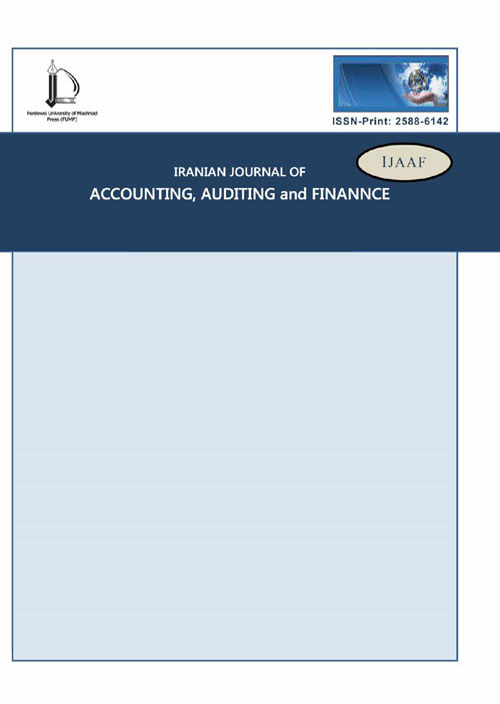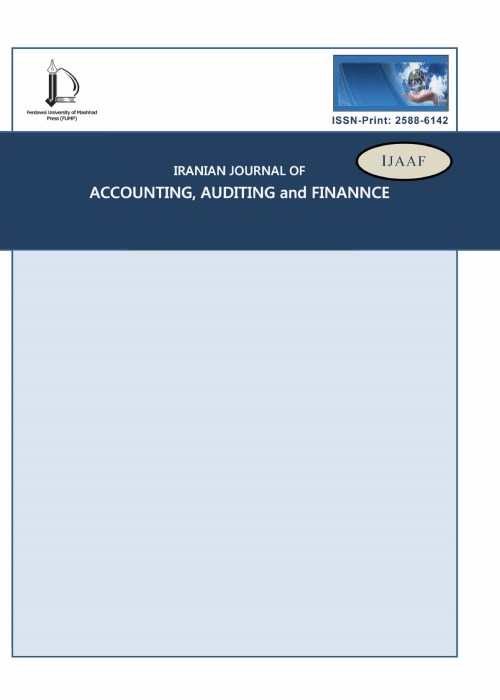فهرست مطالب

Iranian Journal of Accounting, Auditing and Finance
Volume:6 Issue: 2, Spring 2022
- تاریخ انتشار: 1401/03/01
- تعداد عناوین: 7
-
-
Pages 1-17There are two important missions of microfinance banks, financial and social. The social mission has brought to the fore the role of microfinance credit, investment, and other activities in improving the social well-being of the people. Thus, this study aims to examine the effect of the investment activity of microfinance banks on the standard of living in Nigeria between 1992 and 2018 using annual time series data. Based on Autoregressive Distributed Lag (ARDL) model and in the company of cointegrating regression techniques as robustness checks, this study finds evidence of a long-run relationship between standard of living and microfinance investment portfolio, with the lagged value of the latter having a significant negative effect on per capita income (a proxy for standard of living) in the long-run but the significant positive association was confirmed in the short run. The study concludes that microfinance banks’ investment activity is only a short term means of raising the standard of living in Nigeria, for in the long run, rather than raising, it reduces the standard of living in Nigeria significantly. Therefore, it is recommended that microfinance banks' activity be directed towards financially profitable ventures and more socially rewarding outlets capable of improving the social well-being of the people, thereby helping raise the standard of living in Nigeria.Keywords: ARDL, Investment, microfinance banks, portfolio, standard of living
-
Pages 19-35As one of the most critical issues widely discussed in financial studies, the stock price crash is affected by different factors. Despite the importance of this issue for shareholders and investors, the behavioral characteristics of managers responsible for preparing financial statements have not been considered recently. Among those characteristics, the religion and culture of management have been mentioned in this research. Accordingly, the study examines the effect of managers' religion (replacement or complementary effect) and culture on the stock price crash risk in companies listed consistently on the stock exchange until the end of 2019. Therefore, in order to measure the stock price crash risk, two criteria consisting of negative skewness of stock return and down-to-up volatility have been applied. Hofstede's (2001) questionnaire was used to measure culture, and Li and Cai (2016) model was used to measure religion. Then, the results were analyzed by using multivariate regression models. Findings indicate that among the dimensions of culture, the uncertainty avoidance dimension has a negative effect. The dimension of individualism positively affects the stock price crash risk. The dimensions, including power distance and masculinity, do not affect the stock price crash risk. The negative impact of uncertainty avoidance means that conservative risk-averse managers do not make decisions in uncertain conditions. Because they are less inclined to accumulate bad news, they might reduce the stock price crash risk. On the other hand, the positive effect of individualism on the stock price crash risk shows that individualistic managers who do not consult with others about their decisions and insist on their wrong decisions ignore the negative consequences of harmful investments with excessive trust in their decisions and lead to the accumulation of losses in the company and consequently increasing stock price crash risk. The results also show religion's negative and significant effect on the stock price crash risk. Religion reduces the risk of falling stock prices by reducing opportunism and agency problems. In addition, according to the complementarity theory, the sensitivity analysis results show that corporate governance exacerbates the negative relationship between religion and stock price crash risk of companies.Keywords: Alternative, Complementary Theory, Culture, Religion, Stock Price Risk
-
Pages 37-52It is stated in the financial reporting literature that companies in a competitive industry will pursue better disclosure policies. On the other hand, Product market competition substitutes internal governance that reduces agency costs. This study investigates the effect of product market competition on the relationship between the supervisory independence of the firm and the auditor’s opinion on shopping. In this study, four methods have been considered to determine the occurrence of opinion shopping. It is assumed that opinion shopping occurs when one of these four conditions is met. The study sample includes 162 listed companies on the Tehran Stock Exchange during 2014–2019. Research hypotheses were tested by using logistic regression analyses. The results show that if the auditor's opinion shopping criterion is the ratio of the amount of restatement of financial statements to income, the board's independence has a negative and significant relationship with the auditor’s opinion shopping. The research findings also show that the audit committee's independence was not related to the auditor’s opinion shopping criteria. Also, separate tests on the role of product market competition on the above relationships indicate that this variable does not have moderator effects.Keywords: Audit fee, Auditor’s Opinion Shopping, Independence of the Board of Directors, Independence of the Audit Committee, Product Market Competition
-
Pages 53-68
This study investigates the moderating effect of the inflation rate on the relationship between asset revaluation and the financial statements of companies listed on the Tehran and Bombay stock exchanges. In this study, parameters including financial leverage, liquidity, firm size, fixed assets ratio, and firm growth and the data of 112 companies listed on the Tehran Stock Exchange (TSE) and 563 companies listed on the Bombay Stock Exchange (BSE) during the period 2015-2019 are used. Multiple regression is employed to test the research hypotheses to determine the relationship between the dependent and independent variables. F-statistic, F Limmer, and Husman tests are used to test the significance of regression models. The Generalized Least Squares (GLS) method estimates the research models. The results of testing the research hypotheses demonstrate that in both the Tehran and Bombay stock exchanges, without considering the role of the inflation rate, the revaluation of fixed assets is positively and significantly associated with financial leverage, liquidity, and firm size, fixed assets ratio, and firm growth. Moreover, considering the role of the inflation rate, inflation moderates the relationships between financial leverage, liquidity, firm size, fixed assets ratio, firm growth, and the revaluation of fixed assets.
Keywords: Asset Revaluation, Assets Ratio, Firm Growth, Inflation rate, Liquidity -
Pages 69-82Recognising and investigating stock return behaviour has always been one of the most critical issues in scientific and investment communities. In recent years, factor models have been used in many studies related to stock return prediction. This research is based on a six-factor model, including the Fama-French five-factor model plus the market fragility factor. The explanatory power of this model has been examined in the Tehran securities market from 2009 to 2018 for 117 companies. The results show that the explanatory power of the six-factor model is better than the Fama-French five-factor model in the Iranian capital market. The results also suggest that market fragility has a significant negative relationship with stock returns. Policymakers can consider this result in financial and investment issues and people interested in this issue.Keywords: Fama-French five-factor model, Market fragility, Risk, stock returns
-
Pages 83-95
Negative skewness is among the features of crash risk that finally result in more volatility in the negative return. The contributing factors to stock price crash risk spread at the firm level, but the agency cost brings about information asymmetry. Should the information asymmetry between managers and investors be high, negative news about the firms would not transfer to the capital market on time, so when negative information holding passes the threshold, it will spread rapidly in the market and causes a drop in the stock price. According to the empirical observations, corporate governance is designed to decline agency cost and stock price crash risk. Hence, we can consider the auditors as a type of corporate governance effective in reducing agency costs and information asymmetry, so the objective of the present study is to assess the effect of auditor’s characteristics on future stock price crash risk. To reach the study's objective, 90 listed firms on the Tehran Stock Exchange were analyzed for 9 years from 2011 to 2019 using the descriptive-correlation analysis method and the multivariate regression test. The results of this study proved a significant and negative relationship between the auditor's characteristics ( such as consistency in the unqualified opinion and improved audit opinion) and the risk of the stock prices crash in the future. These findings reinforce the role of the audit report in evaluating the reliability of financial reporting and verifying that the auditor’s opinion impacts the market analysis. The results also show that the market can distinguish between the various types of auditors' opinions. Also, they show a negative and significant relationship between an auditor’s characteristics (the tenure of the auditor) and the risk of the characteristics stock prices crash in future. The empirical observations of this study are consistent with the supervised learning paradigm (theory). By showing that the auditors’ characteristics reduce the existing risk in financial markets, the present study contributes to the literature on determining factors in stock price crash risk and is the first study to assess the effect of improved and consistent qualified auditor’s opinion on future stock price crash risk.
Keywords: Auditor’s Tenure, Future Stock, Improved Auditor’s Opinion, stock price crash risk, Qualified Opinion -
Pages 97-109
This study aims to design a technology acceptance model (TAM) to accept financial transactions using blockchain technology and cryptocurrency transactions. By employing an unlimited sample of users by selecting 154 participants based on the Morgan table and analyzing the surveyed data with the Partial Least Squares-Structural Equation Modeling (PLS-SEM). The results indicated that Perceived ease of use and Perceived usefulness positively and significantly impact the attitude toward cryptocurrency transactions supported by blockchain technology. Also, the attitude has a positive and significant impact on Iranian users' behavioral intention toward cryptocurrency transactions supported by blockchain technology. In addition, at a certain level of experience, users feel confident and can trust blockchain-based applications. Accordingly, governments, companies, and decision-makers should consider the results achieved in this study. The current study is the pioneer study in an emerging economy like Iran. The results may help policymakers mandate new regulations to new circumstances. This study mentions the influences of ease of use and usefulness of cryptocurrency transactions supported by blockchain technology.
Keywords: Attitude, Behavioral Intention, Blockchain technology, Technology Acceptance Model (TAM), Perceived Ease of Use, Usefulness


